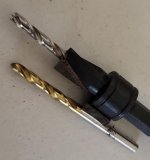I recently purchased a self-centering dowel jig from Garrett-Wade. I made a test joint and it seems quite nice.
However, it included a stern warning that brad point bits must be used with this jig.
I have several types of dowel jigs, some of which come with included drill bits. Not a single brad point bit in any of them.
It is not a problem. I ordered a set from Amazon.com.
But why the stern warning? Why the recommendation at all?
However, it included a stern warning that brad point bits must be used with this jig.
I have several types of dowel jigs, some of which come with included drill bits. Not a single brad point bit in any of them.
It is not a problem. I ordered a set from Amazon.com.
But why the stern warning? Why the recommendation at all?

